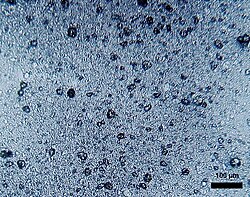
Microplastics (teeny tiny plastic particles) have been detected all around us in the environment, our food, even our organs (e.g., lungs, blood, brain, placentas). Wherever we look, they are found in our bodies, with a recent study finding them in our bones.
The big question is: are these microplastics having a harmful effect on us? The researchers, who reviewed 62 studies, found that yes, microplastics could be harming bone health a number of different ways. They may be weakening our bones, impairing the function of bone marrow stem cells, accelerate cell aging, and could be worsening metabolic bone diseases like osteoporosis.
Microplastics occur as plastic items degrade over time. We breathe microplastics in, eat them (in our food), and drink them in (in water and other liquids). We can't avoid them totally, but we can cut down the amount we are exposed to and ingest - for example, not drinking bottled water (a big source of microplastics), and reducing the amount of plastic furniture, synthetic fabric (e.g., polyester), and synthetic rugs and flooring (e.g., vinyl) in our homes. Also, avoid playing on synthetic turf in playing fields and parks.
From Science Daily: Scientists discover microplastics deep inside human bones
The production and use of over 400 million tons of plastic each year has polluted beaches, rivers, and even the deepest parts of the ocean, reaching depths of up to 11,000 meters. In addition to visible environmental impacts, plastic contributes to climate change. It is estimated that plastic production generates 1.8 billion tons of greenhouse gases per year. Scientific evidence also suggests that using plastic materials in everyday life has impacted human health.
A large number of plastic particles detach from curtains, furniture, clothing, and other plastic objects. These particles remain suspended in the air, dissolve in drinking water, adhere to food, and can be inhaled, ingested, or come into contact with people's skin. Consequently, scientists have found microplastics in blood, the brain, the placenta, breast milk, and human bones.
A study linked to a research project supported by FAPESP and published in the journal Osteoporosis International reviewed 62 scientific articles and found that microplastics have also been harming bone health in various ways. One notable example is their ability to impair the function of bone marrow stem cells by promoting the formation of osteoclasts, which are multinucleated cells that degrade tissue through a process known as bone resorption.
"The potential impact of microplastics on bones is the subject of scientific studies and isn't negligible. For example, in vitro studies with bone tissue cells have shown that microplastics impair cell viability, accelerate cell aging, and alter cell differentiation, in addition to promoting inflammation," says Rodrigo Bueno de Oliveira, coordinator of the Laboratory for Mineral and Bone Studies in Nephrology (LEMON) at the Faculty of Medical Sciences of the State University of Campinas (FCM-UNICAMP), in the state of São Paulo, Brazil.
Oliveira reports that studies on animals have found that accelerated osteoclast senescence can compromise bone microstructure, causing dysplasia. This can lead to bone weakening, deformities, and potentially pathological fractures. "In this study, the adverse effects observed culminated, worryingly, in the interruption of the animals' skeletal growth," says the researcher.
Oliveira further explains that, although the effects of these particles on bone mechanics are not yet fully understood, the data suggest that the presence of the material in the bloodstream, for example, may compromise bone health. "Most strikingly, a significant body of research suggests that microplastics can reach deep into bone tissue, such as bone marrow, and potentially cause disturbances in its metabolism," he says.
Not surprisingly, Oliveira's team is starting a research project to verify in practice what seems perfectly possible in theory: the relationship between exposure to microplastics and the worsening of metabolic bone diseases. Using animal models, the scientists will study the impact of microplastics on the strength of rodent femurs.
